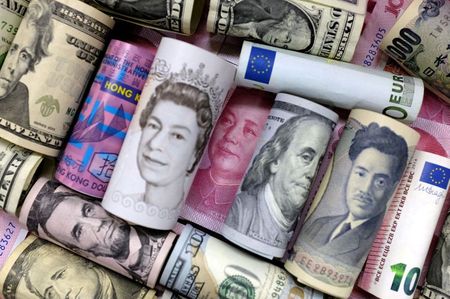By John McCrank
NEW YORK (Reuters) -The dollar edged lower on Friday, along with the Japanese yen, as riskier currencies were favored, with the rally in U.S. Treasuries running out of steam and global stock markets steadying.
Some recent soft U.S. data, along with a surge in COVID-19 cases in many parts of the world, has fueled concerns that the global economic recovery was running out of steam, leading to an eight-day streak of declines for the 10-year Treasury yield that ended on Friday.
“This week was all about the bond market and the collapse in treasury yields,” said Edward Moya, senior market analyst for the Americas at OANDA. “Some of that move was probably overdone.”
The rise in yields supported riskier assets and currencies, with global stock markets rising and the commodity-linked Australian and New Zealand dollars catching a bid.
The Aussie rose 0.79% to $0.74905, after earlier touching a fresh low for the year at $0.7410, and the kiwi added 0.81% to $0.7002, having plunged more than 1% in the previous session.
The euro extended gains on top of a 0.45% jump on Thursday, rising 0.27% to $1.1876.
The dollar index slid 0.252% to 92.131. Graphic: World FX rates https://tmsnrt.rs/2RBWI5E
The greenback’s decline was likely due in part to profit-taking ahead of key U.S. inflation data for June due next week, said Joe Manimbo, senior market analyst at Western Union Business Solutions.
“Dollar bulls are just pulling some chips off the table,” he said.
The yen, perceived as a safe-haven currency, declined as risk appetite began to recover.
“Yesterday’s decline in dollar-yen is reversing together with risk appetite in equities suggesting no wider spillover effects across markets for now – the same move is seen in the U.S. 10-year yield bouncing back above 1.3%,” said Steen Jakobsen, chief investment officer at Saxo Bank.
The yen eased 0.39% to 110.185, giving back some of its gains against the greenback from Thursday, when it had its biggest daily rise since November.
The Canadian dollar strengthened 0.61% against the U.S. dollar to $1.2453 as oil prices rose and data showed Canada added more jobs than expected in June as public health restrictions were eased in several regions of the country.
Elsewhere, the People’s Bank of China said it would cut the reserve requirement ratio (RRR) – the percentage of deposits lenders must hold on to – for all banks by 50 basis points, effective from July 15, helping spur the move back into riskier assets.
“We’re probably going to see some further momentum from this RRR cut and I think we’ll probably see some follow-through once Asia opens on Sunday,” said OANDA’s Moya.
Looking forward, U.S. retail sales numbers for June are also due next week, along with U.S. bank earnings.
Adding to the busy week ahead, U.S. Federal Reserve Chair Jerome Powell is scheduled to appear before Congress, and rate decisions by central banks in Japan, Canada and New Zealand are on tap.
(Reporting by John McCrank; Editing by Andrew Heavens and Alex Richardson)





